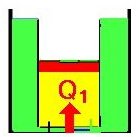Carnot Cycle and Carnot Theorem: Working Principle and Relation to Second Law of Thermodynamics – Part 2
Assumptions of Carnot Cycle
The Carnot cycle comprises two reversible isothermal and two reversible adiabatic processes. Both of these are ideal process which cannot be achieved in practical situations. A Carnot engine can be considered to be similar to piston and cylinder type of engine. While proposing the processes, Carnot made certain assumptions as given below:
-
There is no friction at all between the piston and cylinder and other moving parts of the engine, thus there is no heat generated and lost due to friction.
-
There is also no exchange of heat between various parts of the engine.
-
The engine is completely insulated; hence there is no transfer of heat with the external atmosphere.
Carnot Cycle (Source: Wikipedia)

Carnot Cycle
To understand the Carnot cycle, let us consider the piston and cylinder arrangement as shown in figure 1 and the accompanying P-V diagram in which all the four processes of the Carnot cycle are shown.
-
Reversible isothermal process 1-2: During this process the piston starts moving outside the cylinder. The working fluid air or steam absorbs heat Q1 isothermally from the high temperatures reservoir which is at temperature T1. Since the heat is absorbed by the fluid, its internal energy increases. During this process the cylinder is assumed to be covered with diathermic cover.
-
Reversible adiabatic process 2-3: During this process the piston moves further outwards from position 2 to 3 reversibly and adiabatically. During this process the work is generated by the system at the expense of the internal energy and the temperature of the system reduces from T1 to T2. The system is assumed to be covered with adiabatic cover which prevents the exchange of heat with the surroundings.
-
Reversible isothermal process 3-4: During this process the system of piston and cylinder loses heat Q2 isothermally and reversibly to the surrounding or sink at temperature T2. The internal energy of the system reduces further. The piston starts moving inside the cylinder.
-
Reversible adiabatic process 4-1: During this process external work is done on the system and the fluid within the cylinder is compressed. Due to this the temperature of the fluid increases from T1 to T2. The process is reversible adiabatic hence the heat content of the system remains constant.
Efficiency of the Carnot Cycle
From the above cycle the efficiency of the Carnot cycle can be found out as:
Efficiency of the cycle = Work output/ Heat supplied
The final expression for the efficiency of Carnot cycle is (T1-T2)/T1 or 1-T1/T2
Where: T1 and T2 are the absolute temperatures (in degree Kelvin) of the high and low temperature reservoirs respectively.
Carnot Theorem
Finally we come to Carnot’s theorem, which is in fact the summary of all the findings and discussions stated above. It states that of all the heat engines operating between a given constant temperature source and a given constant temperature sink, none has a higher efficiency than a reversible engine.
Back: Part-1 of this article
Related Reading
Who Invented Thermodynamics? Biography of Sadi Carnot – Part 1
Types of Thermodynamic Systems and Important Terms Related to Thermodynamics - Part 1
